Related Research Articles
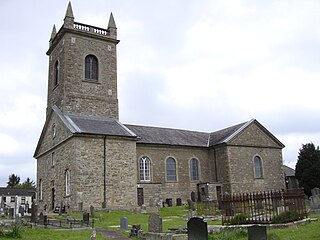
The Bishop of Clogher is an episcopal title which takes its name after the village of Clogher in County Tyrone, Northern Ireland. Following the Reformation, there are now parallel apostolic successions: one of the Church of Ireland and the other of the Roman Catholic Church.

Giovanni Battista Rinuccini (1592–1653) was an Italian Roman Catholic archbishop in the mid-seventeenth century. He was a noted legal scholar and became chamberlain to Pope Gregory XV. In 1625 Pope Urban VIII made him the Archbishop of Fermo in Italy. In 1645 Pope Innocent X sent him to Ireland as Papal Nuncio. He brought money and weapons to help the Confederate Irish in its conflict against the English Parliamentarians. Rinuccini became the dominant figure of the hard-line Clerical Faction of the Confederates refusing the alliance with the Irish Royalists.
Finan of Lindisfarne, also known as Saint Finan, was an Irish monk, trained at Iona Abbey in Scotland, who became the second bishop of Lindisfarne from 651 until 661.
The Bishop of Killaloe is an episcopal title which takes its name after the town of Killaloe in County Clare, Ireland. In the Roman Catholic Church it remains a separate title, but in the Church of Ireland it has been united with other bishoprics.
Events from the year 1697 in Ireland.
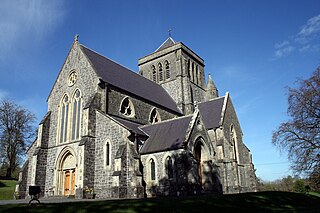
The Bishop of Kilmore is an episcopal title which takes its name after the parish of Kilmore, County Cavan in Ireland. In the Roman Catholic Church it remains a separate title, but in the Church of Ireland it has been united with other bishoprics.
William O'Meara was a Roman Catholic Bishop in the 18th century.
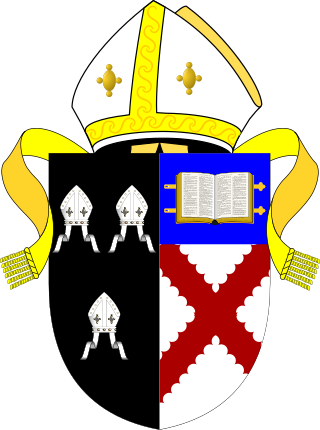
The United Dioceses of Meath and Kildare is a diocese in the Church of Ireland located in the Republic of Ireland. The diocese is in the ecclesiastical province of Dublin. Alone of English and Irish bishops who are not also archbishops, the Bishop of Meath and Kildare is styled "The Most Reverend".
The Bishop of Ardfert and Aghadoe was an episcopal title which took its name after the village of Ardfert and townland of Aghadoe, both in County Kerry, Republic of Ireland.
The Bishop of Kerry is the Ordinary of the Roman Catholic Diocese of Kerry, one of the suffragan dioceses of the Archdiocese of Cashel and Emly in Ireland.

The Archbishop of Armagh is an archiepiscopal title which takes its name from the city of Armagh in Northern Ireland. Since the Reformation, there have been parallel apostolic successions to the title: one in the Roman Catholic Church and the other in the Church of Ireland. The archbishop of each denomination also holds the title of Primate of All Ireland.
The Bishop of Cork and Ross is an episcopal title which takes its name after the city of Cork and the County Cork town of Rosscarbery in the Republic of Ireland. The combined title was first used by the Church of Ireland from 1638 to 1660 and again from 1679 to 1835. At present the title is being used by the Roman Catholic Church.
The Bishop of Dromore is an episcopal title which takes its name after the original monastery of Dromore in County Down, Northern Ireland. In the Roman Catholic Church the title still continues as a separate bishopric, but in the Church of Ireland it has been united with other bishoprics.
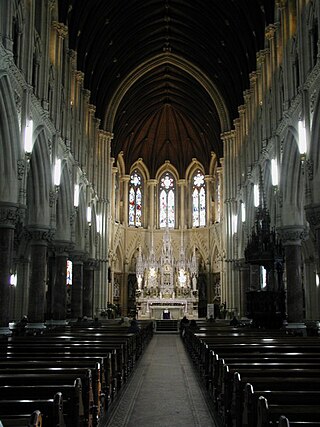
The Diocese of Cloyne is a Roman Catholic diocese in Ireland. It is one of six suffragan dioceses in the ecclesiastical province of Cashel.
John Mangan was an Irish Roman Catholic bishop.
Charles O'Sullivan was an Irish Roman Catholic bishop.
Michael O'Brien, DD was an Irish Roman Catholic Bishop in the mid 20th century.
Michael Murphy was an Irish Catholic bishop in the last quarter of the 20th Century.
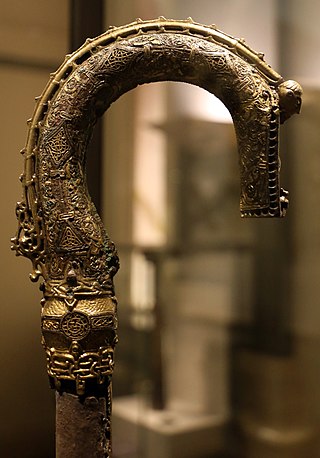
The River Laune Crozier is a late 11th-century Insular crozier, now at the Archaeology branch of the National Museum of Ireland. The object would have been commissioned as a staff of office for a senior clergyman, most likely a bishop. It consists of a wooden core decorated with fitted bronze and silver metal plates. Although the metalwork is somewhat corroded in parts, it is fully intact and considered one of the finest surviving Irish examples, alongside those found at Clonmacnoise and Lismore.

The Diocese of Tuam, Limerick and Killaloe is a diocese of the Church of Ireland that is located in the west of Ireland. The diocese was formed by a merger of the former Diocese of Tuam, Killala and Achonry and the former Diocese of Limerick and Killaloe in 2022, after the retirement of the separate dioceses' bishops and the appointment of Michael Burrows as bishop of the united diocese. It is in the ecclesiastical province of Dublin. It is one of the eleven Church of Ireland dioceses that cover the whole of Ireland. The largest diocese by area in the Church of Ireland, it covers all of counties Clare, Galway, Kerry, Limerick and Mayo, plus parts of counties Cork, Sligo, Roscommon, Offaly, Laois and Tipperary.
References
- ↑ The Post-Reformation Bishops of Kerry Kerry Archaeological Magazine Vol. 4, No. 20 (Apr., 1918), pp. 265-272
- ↑ Catholic Hierarchy
- ↑ Fryde, E. B.; Greenway, D. E.; Porter, S.; Roy, I. (1986). Handbook of British Chronology (Third ed.). Cambridge: Cambridge University Press. pp. 332–334. ISBN 0-521-56350-X.
- ↑ Find a grave